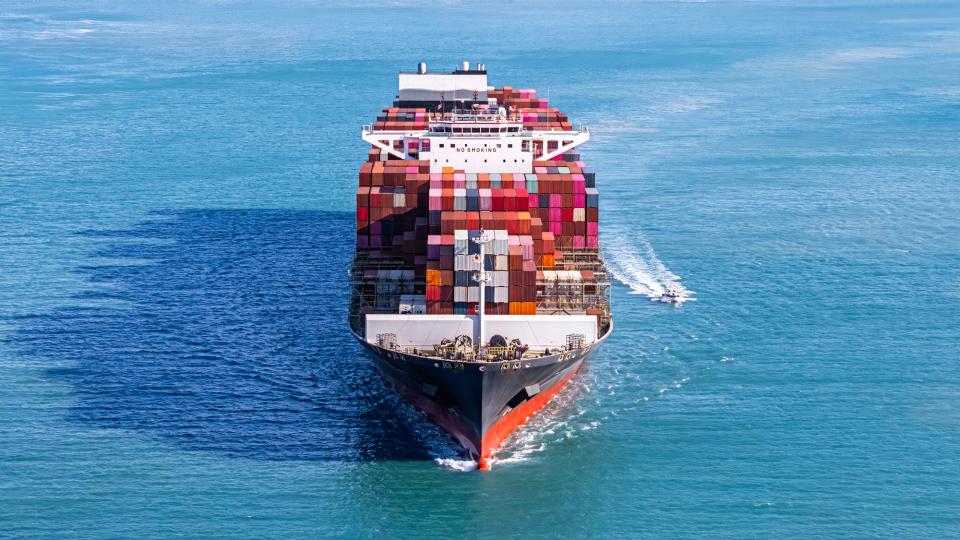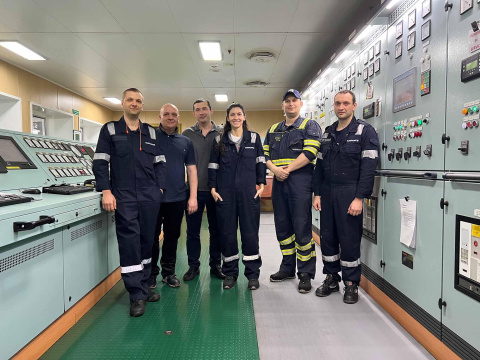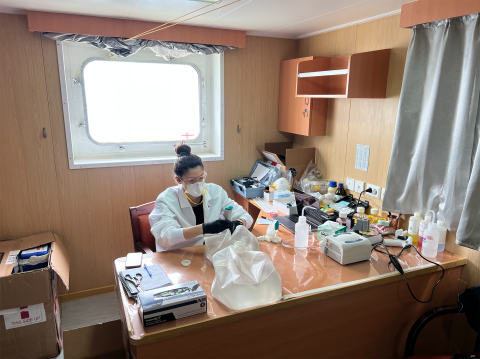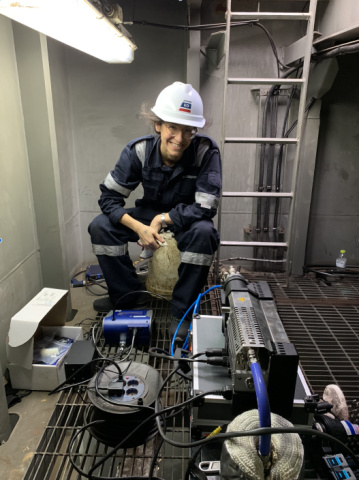Researchers Help Maritime Industry Navigate Toward Sustainability - Cloned

Ocean shipping, the backbone of international trade, is significantly more energy efficient than air or land transport. However, cutting down on ocean freight carbon emissions will require a great deal of collaboration and effort.
When people think of greenhouse gas emissions from transportation, what often comes to mind are airplanes and land vehicles like cars or trucks. But as efforts to slow climate change are ramping up, the spotlight is on another form of transport: ships.
The U.N.’s International Maritime Organization (IMO) has set targets to reduce shipping greenhouse gas emissions by at least 40% by 2030 and 70% by 2040, aiming for net-zero by 2050. Shipping currently accounts for about 3% of global annual greenhouse gas emissions, and the pressure is on shipping companies to meet these ambitious goals.
Across Georgia Tech, researchers are working toward a sustainable future for ocean shipping. This includes Valerie Thomas, the Anderson-Interface Chair of Natural Systems Professor in the H. Milton Stewart School of Industrial and Systems Engineering, and in the School of Public Policy. She is scholar of energy systems, sustainability, assessment, and low-carbon transportation fuels, and her work touches many aspects of the maritime industry.
Finding Sustainable Solutions
“Today, we ship a lot of goods by ocean freight, and there is certainly an environmental impact with shipping,” Thomas said. “But the emissions from shipping a product from East Asia to the U.S. on a bulk carrier vessel are significantly lower than trucking a product across the U.S. When ships are filled to the brim with cargo and are moving slowly across oceans, this is energy efficient, fuel efficient, and even cost efficient per ton of ‘stuff’ transported.”
While ocean shipping is significantly more energy efficient than air or land transport and contributes far fewer emissions, Thomas says cutting down on ocean freight emissions will require a great deal more effort. One way is to find more eco-friendly fuels.
“I look at big systems, and one of those areas is investigating alternative fuels,” Thomas said. “I’m often trying to figure out how much greenhouse gas various fuels emit, what other types of emissions or matter are coming out, and how to compare different fuel options.”
Thomas is a leading expert in life-cycle assessment. It is a method used to evaluate a fuel or technology's environmental impact throughout its entire cycle — from raw materials extraction, processing, manufacturing, distribution, and ultimately, use. Right now, basically all ships use petroleum fuels, which emit carbon dioxide and particulate matter into the air.
Finding fuel alternatives is not a simple task: Just because a fuel might initially seem like a promising low-carbon option, that is not always the case in the end. Thomas’s expertise in life-cycle assessments helps her figure out whether these possible fuels are truly environmentally friendly.
“One such example is hydrogen: It doesn’t emit carbon dioxide when burned,” Thomas said. “But the manufacturing of hydrogen can emit carbon dioxide, and therefore, hydrogen is not always a low-carbon fuel on a lifecycle basis.”
Helping the Shipping Industry Cut Carbon
Patricia Stathatou, a researcher at Georgia Tech’s Renewable Bioproducts Institute, specializes in sustainability assessment of chemical engineering processes and products, which includes lifecycle assessments and techno-economic assessments, evaluating both the environmental impacts and the economic viability of products and processes. Stathatou, who will join the School of Chemical and Biomolecular Engineering as an assistant professor in January 2025, also conducts experiments to support these assessments and guide the development of new technologies.
“My contribution to the lifecycle assessment field is that I support assessments with in-field emission monitoring, taking samples, and performing chemical analyses,” Stathatou said. “This helps identify specific pollutants that might be emitted into the air or be present in water, wastewater, or solid waste streams.”
But as maritime shipping companies rise to the challenge of cutting emissions, they often do not know where to start. This is where Stathatou’s experience comes in.
During her postdoctoral research at MIT, a major shipping company reached out to Stathatou and her colleagues asking for help in cutting emissions. They wanted to increase the energy efficiency of their fleet and investigate different strategies and technologies to eventually reach the IMO’s emissions goals.
Because of Stathatou’s expertise in alternative fuels, biofuels, and sustainable energy sources, she investigated potential solutions for the company, which included a six-day research trip monitoring emissions aboard one of the company’s bulk carrier vessels in East Asia. Her work involves designing experiments, measuring emissions, and evaluating the environmental impact of different fuels onboard bulk carrier vessels.
“Ten years ago, there weren't rigorous goals or guidelines for reducing emissions in the shipping industry — and not much scientific collaboration in the process,” Stathatou said. “If we are to make a difference in the industry in regard to climate, we need partnerships with shipping companies to help guide their efforts.”
Stathatou plans to continue her collaborations with shipping companies and expects to carry out more on-ship evaluations soon.
The Big Picture
According to Thomas, a holistic approach is needed to make shipping more sustainable. "It's not just about the fuels we use; it's about optimizing supply chains, reducing empty freight, and leveraging multimodal transportation options," Thomas said. "By embracing net-zero freight initiatives and maximizing efficiency in logistics, we can achieve meaningful reductions in emissions while meeting the demands of global trade."
Encouraging shifts to ocean freight is another means of reducing emissions. For example, if a company wants to transport goods from Miami to Baltimore, they don’t need to go by road or rail. “You can ship your freight on the ocean along the coast, and that could be more environmentally efficient,” Thomas said.
The work Thomas and Stathatou do is part of a broad portfolio of shipping sustainability research at Georgia Tech, which also includes the Georgia Tech Supply Chain and Logistics Institute, the Panama Logistics and Innovation Research Center, and the Net Zero Freight Systems Program, which Thomas co-leads. These partnerships aim to enhance the efficiency and sustainability of global supply chains, leveraging innovative research and practical applications.
“The work of evaluating different fuels, technologies, and strategies is not trivial, and figuring out these new methods does not happen quickly,” Thomas said. “These are difficult technologies, and it takes a long time to put them in place. That is why we need to do this work now.”
Stathatou envisions that, with more shipping companies now looking to curb their emissions, there will be significant adoption of new fuels and technologies within the next decade.
“Ocean shipping is a transportation sector that we cannot go without, and so decarbonizing it is very important,” Stathatou said. “I believe the ability to perform these assessments and guide the development of future solutions will have a tremendous impact on humanity.”
Additional Media

Valerie Thomas, the Anderson-Interface Chair of Natural Systems Professor in the H. Milton Stewart School of Industrial and Systems Engineering, and in the School of Public Policy.

Patricia Stathatou (third from right), a researcher at the Renewable Bioproducts Institute, with the carrier vessel's crew members. (Credit: Patricia Stathatou)

Stathatou preserving water and washwater samples from the vessel's scrubber so they can be stored and analyzed later in the lab. (Credit: Patricia Stathatou)

Stathatou prepares to measure particulate matter emissions in the vessel's funnel — a very windy area of the ship. (Credit: Patricia Stathatou)